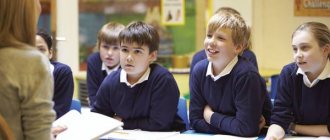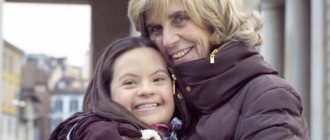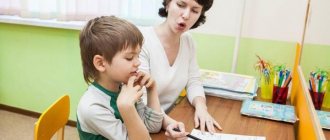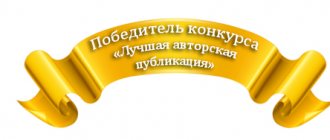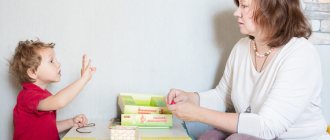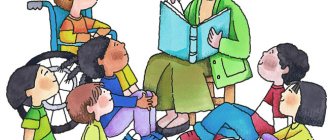Development of speech understanding.
The need for speech therapy sessions with non-speaking young children.
In a situation where a 2-2.5 year old child does not have active speech, teachers and parents are faced with the question: is it necessary to immediately begin special speech therapy classes or should it wait?
Parents usually compare the child's speech development with the level of speech development of his peers. And, of course, they begin to worry about the fact that the child is lagging behind in speech development. However, at the everyday level, there are ideas that “boys generally start talking later,” or “it happens that he is silent, silent, and then speaks,” etc.
Speech therapists at the clinic often advise you to wait a little. This can be explained by the fact that working with children requires a special approach, but not every specialist has the necessary knowledge, experience, or desire to work with young children. It is much easier to conduct classes with a 4.5-5 year old child, whose behavior is already quite arbitrary.
In our opinion, if there is no active speech in a 2-3 year old child, it is necessary to organize a consultation with competent specialists - a speech therapist, psychologist, psychoneurologist, otolaryngologist, conduct a series of medical examinations, and, if necessary, organize classes with the child. Observations by specialists, medical research data, as well as the dynamics of the child’s development during special classes make it possible to clarify the nature of the disorder, possible causes, and the degree of its complexity.
At an early age, developmental disorders are not yet differentiated by their external manifestations, but impaired speech development to one degree or another accompanies any defect. Organizing observation of the child and corrective classes will help differentiate speech disorders from other disorders (mental retardation, mental retardation, hearing impairment, autism), and make a more accurate diagnosis of speech disorders (general speech underdevelopment or delayed speech development).
At the same time, some children who had similar speech disorders in early and preschool age, with systematic speech therapy sessions, can completely overcome their speech defect and subsequently study successfully in a public school. Another part of children, even during systematic studies, are not able to completely overcome their speech impairment; at school age, problems arise with the acquisition of written speech (dysgraphia, dyslexia). In the first case, we can talk about SRD ( delayed speech development ), in the second case – about GSD ( general speech underdevelopment ).
During special speech therapy sessions with young children, parents usually raise the question of predicting the child’s speech development in the short and long term. How possible is it to make such a forecast? The fact is that in early and preschool age, in children with speech disorders of varying degrees of complexity, the level of general and speech development may look approximately the same. Therefore, assumptions about the further development of a child’s speech can only be made taking into account the dynamics of speech development during speech therapy training.
This article describes the initial stage of speech therapy work - a system of classes aimed at developing a non-speaking child’s understanding of spoken speech. These activities and games were carried out by the author of the article during speech therapy work with children with delayed speech development and general speech underdevelopment, and gave very good results. In addition, the games described below have been successfully used in working with young children with other disorders: mental retardation (mental retardation), mental retardation, emotional-volitional disorders.
The games described below should be played individually or in small groups. Taking into account the psychological characteristics of an early age - involuntary behavior, short attention span, unformed communication with peers, etc. - we recommend introducing children to new material during individual work. And in group classes it is useful to consolidate material already familiar to children and to use children’s new knowledge during common games.
In the process of classes to develop speech understanding, the main task of speech therapy is the accumulation of children’s passive vocabulary: words-objects and words-actions, as well as words denoting certain phenomena and states. For memorization, children are offered only those words that denote familiar objects, actions, phenomena and conditions that they constantly encounter in everyday life, what they can observe, what they can act with, what they feel. When working with non-speaking children, it is not recommended to overload their passive vocabulary with words with an abstract meaning or generalizing words. Here is a dictionary of recommended words for memorizing by topic.
Is it necessary to teach literacy?
More and more modern parents strive to ensure that their child can count and know the entire alphabet by the age of 3-4. You need to understand that the brain of a small child cannot perceive a large amount of information and the concentration of his attention is not enough for long lessons. It is necessary to proceed from the individual characteristics of the child; if reading is taught incorrectly, it will be mechanical.
Speech therapists recommend using the primer by N. S. Zhukova, where the study of letters is given in ontogenetic order, that is, the study begins with those letters that are easiest for the child. The baby needs to be taught to correlate sounds and letters. There is no need to force children to learn the entire alphabet by the age of 4. It is much more important to pay attention to the child’s overall speech development. After all, correct, beautiful speech is the basis for successful learning and socialization.
Groups of words suggested for memorization.
1. Subject dictionary.
Toys: ball, cube, car, doll, bear, bunny, ball, spinning top, bucket, shovel, pencils, book, etc. Parts of the body, face: legs, arms, belly, back, finger, head, neck, hair, eyes , ears, mouth, lips, teeth, nose, cheeks, eyebrows, forehead. Clothing and footwear: hat, scarf, mittens, jacket, coat, dress, skirt, blouse, shirt, trousers, tights, briefs, T-shirt, socks, slippers, boots, shoes, sandals, etc. Toilet items: soap, toothbrush, toothpaste, sponge, towel, comb, handkerchief, etc. House, apartment: house, door, lock, key, stairs, elevator, window, kitchen, room, bathroom, lamp, floor, ceiling, wall, etc. Furniture: table, chair, sofa, bed, wardrobe, shelf, hanger, etc. Household items: TV, telephone, clock, stove, refrigerator, fork, spoon, plate, cup, blanket, pillow, mirror, etc. Food and dishes : bread, bun, cheese, sausage, sausages, milk, butter, sour cream, cottage cheese, yogurt, cookies, juice, egg; porridge, soup, salad, sandwich, tea, compote, etc. Vegetables and fruits: cabbage, potatoes, carrots, onions, cucumbers, tomatoes; orange, banana, apple, pear, plum, etc. Plants: tree, bush, grass, flowers, berries, etc. Names of animals and birds that the child often sees: dog, cat, bird, dove, sparrow, crow, horse, etc. etc. Individual names of objects in the surrounding life: street, road, traffic light, cars, plane, swing, slide, park, etc. Individual names of phenomena in the surrounding life: water, earth, sun, sky, rain, snow, night, day, etc.
2. Verb dictionary.
The child’s own actions: walks, sits, stands, runs, jumps, sleeps, eats, plays, draws, builds, walks, rolls, washes, bathes, dresses, undresses, combs his hair, carries, falls, screams, speaks, sweeps, wipes and etc. Names of actions that people close to the child perform: reads, writes, draws, cleans, washes, irons, cooks, fries, sweeps, etc. Other actions: the phone rings; the car drives and hums; The plane is flying; leaves are falling, etc.
3. Adjectives, adverbs.
Names of some sensations and states: sweet, salty, sour, wet; cold, warm, hot, painful, tasty.
The name of some concepts: big, small; a lot, a little.
Work to expand the passive vocabulary of non-speaking children 2-3 years old is carried out both by a speech therapist and by the child’s relatives. Therefore, a speech therapist not only works with the child, but also works with parents.
Working with parents.
The main task of working with parents is to explain how to behave towards the child, how to create a rich speech environment for him in the case of a speech disorder. The speech therapist must explain to the parents or other loved ones of the child that the development of the child’s speech requires more careful attention and special work at home; one should not rely only on classes with a speech therapist. Parents must realize that if there is a delay in speech development, a new approach to raising the child at home should be adopted.
1. Creation of a speech environment. This means the following: you need to constantly talk to the child, repeatedly talking through all routine moments (dressing and undressing, washing, bathing, eating, walking, getting ready for bed), and various everyday situations (putting toys in their places, preparing food, clearing the table , washing dishes, sweeping the floor, etc.). The same work should be done while playing with toys and pictures, and while reading books.
At the same time, the adult speaks in simple short sentences of 2-4 words, uses the same phrases several times, pauses, uses different intonations, and different voice strengths. Words are pronounced clearly, with emphasis on the stressed syllable, for which the stressed syllable is slightly stretched.
An adult often turns to the child and asks questions. But you should not demand an immediate answer from the baby. Thus, the adult asks a question, pauses, then answers the question himself. After the child has heard the name of an object many times, taken it, felt and examined it, acted with it, you can ask the child to bring (show, find, give) a familiar object, or perform some action with it. Here are examples of how adults talk through various situations.
Washing. Let's go wash up. Let's open the tap. No, not in that direction, in the other direction. Like this. Where's the soap? Here's the soap. Take soap and wash your hands. Put the soap in the soap dish. Let me help you. Three pens are good. Now let's wash off the soap. Place your hands under the water - like this. Now let's wash our face - like this. Take water into your palms and rub your face. Close the tap. Now let's shake the water off the handles - like this. Where's the towel? Take a towel and dry your face and hands. Well done! Look how clean it has become.
Packing for a walk. (All the necessary things are laid out on the chair) Now you and I will go for a walk. Find where our pants are. Here they are. Let's put on our pants - like this. First on one leg, then on the other leg. Now let's fasten the button. Show me where the button is. Bring a blouse. Oh, what a beautiful, warm blouse. What's this on the blouse? Pocket. Find where the bear is hidden on the blouse. That's right, here it is. Where's the flower? Here. Let's put on a blouse. Etc.
On a walk. Look what the weather is like today. Yes, it's raining. Put on your hood. And I will open my umbrella. Like this. Now you can walk. What's that on the path? This is a puddle. There is water in the puddle. The rain dripped and dripped - and it turned out to be a puddle. Let's go further. Here's a tree. Look what it is under the tree? These are the leaves that have fallen. Here is a yellow leaf. What color is this leaf? Red leaf. Lots of leaves. Show me how many leaves there are. Etc.
Cooking lunch. (When preparing food together, be careful and insure the child) I am preparing soup. Will you help me? Here's a saucepan. Pour some water into the pan and put it on the stove. Let's cook soup. Here are the potatoes. And this is a knife. It's sharp, you can't touch it. I cut the potatoes, look, they turned out to be pieces. And you throw the potato pieces into the saucepan. Be careful, the stove is hot! And what's that? Carrots and onions. Throw it into the pan. Now let's stir things up. How will you stir the soup? (Offer your child a choice of fork, spoon, spatula, ladle, or chopstick.) Now salt the soup. Like this. Etc.
Let's build a house. (Uses a set of wooden or plastic cubes) Look at the cubes we have. Show me where the red cube is. That's right, here it is. Where's the yellow one? Where's the blue cube? Right here. Let's build a house out of cubes. What kind of house will it be - big or small? Show me. Big? Fine. Here I have placed the cubes. Now you bet. Put it here. Etc.
2. Keeping a diary. In addition to creating a speech environment for the child, parents are recommended to keep a diary in which a record of the child’s active vocabulary is kept - all the words that the child uses (in the form in which he pronounces them, as well as a “decoding” of the meaning), and a passive vocabulary - those words whose meaning the child understands. Dates should be written next to the words. If parents are attentive enough, then when keeping a diary it becomes possible to clearly see the dynamics of the development of the child’s speech. It is also useful to describe in the diary the activities and games that are already being carried out with the child, and which are planned to be carried out. This is convenient when different family members are involved with the child.
3. Carrying out tasks of a speech therapist. In addition to the above, the child’s relatives must complete the tasks of the speech therapist. This includes the purchase of necessary educational toys, manuals, books; preparing photographs from the life of the child and family that will be used in classes; consolidation of material covered in class, etc.
Working with a child.
The work of a speech therapist with a child includes a system of special classes. If parents develop an understanding of the baby’s speech during routine moments and everyday situations, then the speech therapist expands the child’s passive vocabulary during special games, using various materials and toys, as well as special techniques. Here are descriptions of some games.
Speech imitation
A child’s reproduction of sounds, words, and phrases is called speech imitation.
It is meaningful only when speech is closely related to the child’s actions.
An adult should stimulate the child's speech with questions.
Words to be repeated must be pronounced many times; do not repeat the child’s “substitute words.” The child’s answers are accepted in any form.
The most important thing is to do everything possible so that the child does not hesitate to speak.
Speech imitation goes through several stages:
- Copying sounds that have a certain meaning.
- Repetition of amorphous words (kup-kup - swim, am-am - eat, lalya - doll).
- Repetition of simple words (baba, grandfather, drink).
- Repeating short phrases: “Give me the juice!” Where's the spoon?
Pay great attention to the use of verbs. If a child’s speech contains many action words, his level of development is quite high.
Games with speech imitation
An effective way to induce speech imitation is the use of poetic texts - finishing words and phrases by creating pauses when reading poetry.
For example:
They love... (monkeys) very much
Eat sweets... (bananas).
We are like monkeys... (look like)
And we love bananas... (too).
Gradually, the number of pauses (words skipped by adults) can be increased, thereby increasing the child’s vocabulary.
Fun games in the form of a conversation: an adult repeats a word several times, then asks the child a question, the answer to which is the highlighted word. If the question is answered correctly, the adult praises the child; if the question is answered incorrectly, he answers the question himself or offers several answer options.
1. Hide and seek.
Goal: to clarify and expand children’s passive subject vocabulary on the topic “Toys.” Materials: toys - a bear, a bunny, a car, a ball, a doll, a bucket, etc. Progress of the game: Before starting the game, place the toys in different places in the room - on a chair, under a table, on a shelf, on the floor and in other places. Toys must be clearly visible. Offer the children a game. The doll Masha came to us. She's crying. Do you know why the Masha doll cries? Because all the toys were hidden from her! Let's help Masha find toys. Vanya, find the bear. Well done, Vanechka, you found the bear! Look how happy Masha is. And you, Olya, please find the ball. Can't find it? Look down on the floor. Etc. In this game you can use not only various toys, but also pictures depicting toys. Gradually increase the number of toys and pictures. You can give one child the task of finding and bringing two toys (pictures). In the future, you can use a variety of objects familiar to children.
"Goat"
Goal: to develop speech hearing, articulatory apparatus, pronounce words and expressive movements, and expand vocabulary. Materials: goat toy.
Class
Take a toy and start a dialogue:
-Who came to us? The goat is horned, butted. Don't be afraid of the goat, but let's talk to her. Say: “Hello, little goat! We are glad to see you!”
Encourage your child to express his initiative.
- What does the goat give us? Milk? Where's your cup? Substitute and drink warm milk!
Imitate conditional actions.
- Tell her thank you for the tasty and healthy milk. Where are the goat's eyes? Horns?
Give your child the opportunity to show all parts of the body, encouraging action.
-Where does the goat graze? What does he eat? How does she run? How does he cast his voice?
In the process of communication, the child develops grammatical speech, pronunciation of vowels, whistling sounds and simple consonants.
2.Who has the picture?
Goal: clarification and expansion of children’s passive subject vocabulary on various topics. Materials: subject pictures on different topics according to the number of children. How to play: Before starting the game, choose a topic, then distribute one subject picture to the children. Look how beautiful your pictures are. They are all different. Let's play an interesting game. I will say the word, and you listen carefully. Whoever has such a picture, let him raise his hand. Flower. Masha raised her hand. That's right, Masha, you have a flower in the picture. Show everyone your flower. The next word is bird. Who has the bird? Nobody raises their hand... Where is the bird? Who will find the bird? Here's a bird from Dima! Dima, raise your hand. Etc. In this game you can change the themes by using different words and pictures according to the dictionary above. Pictures should be specific, easily recognizable, and depict objects familiar to the child. Over time, you can increase the number of pictures used in the game (for example, distribute two pictures).
3.Show the picture!
Goal: clarification and expansion of children’s passive subject vocabulary on various topics. Materials: subject pictures on different topics according to the number of children. How to play: The game is played on the carpet. Place the children in a circle on the floor. Place object pictures face up in front of them. Take turns asking the children to find and show the correct picture. Look how many beautiful pictures we have. All pictures are different. Vanya, show me the cube. Right. Lena, find and show the pyramid. Well done! Sasha, show me the plane. Etc. In this game you can select pictures by theme, or you can mix pictures from different themes. Over time, you can increase the number of pictures used in the game.
4.Guess the riddle - show me the answer!
Goal: clarification and expansion of children’s passive subject vocabulary on various topics; teach children to recognize objects by their purpose; development of children's thinking. Materials: subject pictures on various topics. How to play: The game is played on the carpet. Place the children in a circle on the floor. Place object pictures face up in front of them. You can give general instructions for everyone, or you can give instructions individually for each child. And now we will solve riddles. Let's see which of you is the most attentive. Show what people eat the soup with (the picture is a “spoon”). Show what is rolling (the picture is “ball”). Show what you can use to draw with (the picture is a “pencil”). Show what they put on your head (picture “hat”) Find and show what you can eat (pictures “apple”, “candy”, “cheese”) Etc. If children find it difficult to find the right picture, you can give a more detailed description of the desired item. If the children could not find the right picture, you should show them a real object, describe its properties, and play with it.
5. Fun riddles!
Goal: clarification and expansion of children’s passive subject vocabulary on various topics; teach children to recognize toys and objects by description. Materials: various toys and objects. How to play: The game is played on the carpet. Place the children in a circle on the floor. Place several different toys or objects in front of them. You can give general instructions for everyone, or you can give instructions individually for each child. And I know other interesting riddles. I will talk about some toy (object), and you guess what I’m talking about and show it. Let's see which of you is the most attentive. It is round, blue, and rolls (the ball). He is white, fluffy, with long ears and a small tail (bunny). It is long, wooden, and used for drawing (pencil). Etc.
"Early, early in the morning"
Goal : develop speech hearing, articulatory apparatus, pronounce words and expressive movement, encourage proactive statements. Material: toys: pipe, cow.
Class
Show your child the pipe and demonstrate how it plays. Ask: “How does the pipe sing? Doo-doo-doo.” Repeat the sounds and movements with your child.
Play out a story game in which a shepherd boy uses his pipe to collect cows. “How does the shepherd play the pipe? Doo-doo-doo"
Read the poem:
Early - early in the morning The shepherd tu-ru-ru-ru! And the cows chanted in harmony with him: “Moo-mu-mu!
How does a cow moo? Mu-mu-mu - together.
Ask: “Where are the cow’s ears? Eyes? Horns?" Correlate words and gestures, touching parts of the body, expressing conditional actions.
Tell your child about the cow: what does it eat, what benefits does it bring to people, where and how does it sleep? What does the baby know about her? Help and encourage him to speak up and express his thoughts.
6. Follow commands!
Goal: clarification and expansion of the passive verbal dictionary of children. How to play: The game is played on the carpet. Place children at a sufficient distance so that they do not interfere with each other's movements. Stand in front of the children. Let's play this game: I will give commands, and you carry them out. Listen carefully and make no mistakes! Let's start! Go. Stop. Raise your hands up. Put your hands down. Sit down. Stand up. Jump. Run. Clap. Stomp. Place your hands on your belt. Etc. In this game, you can use simple movements familiar to children, which were practiced in an imitative game, when the teacher named and performed the movement, and the children repeated after him. The teacher monitors the children’s movements and corrects mistakes.
7.What is the little man doing?
Goal: clarification and expansion of the passive verbal dictionary of children. Materials: a set of pictures depicting various actions according to the number of children. How to play: Before starting the game, give the children one picture each. Look, in your pictures there are boys and girls doing something. Let's play an interesting game. I will make plans for actions, and you listen carefully. Let the one who has a suitable picture raise his hand. Who's sitting? Who's standing? Who's lying? Who's riding? Who's eating? Who drinks? Who is jumping? Etc. If kids find it difficult to answer, you can give a hint by expanding the instructions. To do this, add a description of the items that are in the picture. Who eats the apple? Who swings on the swing? Who is sitting on the chair? And so on.
Role-playing games
Role-playing games are a very fertile environment for speech development. During the game, a child has a natural need to say something: he needs to somehow name the main characters of the game and their actions, express his thoughts and feelings.
Read more about how to play role-playing games with a 1-2 year old child here.
8.Who does what? (use of photographs)
Goal: clarification and expansion of the passive verbal dictionary of children. Materials: To play this game, you need to ask parents to take photographs in which the child performs various actions (see dictionary). How to play: Children love to look at photographs of themselves. It is useful to use this in speech therapy classes. This game is initially played individually, using photographs of the child. At first, you can use only part of the photos. Gradually, as you master the material, add the rest. Place the photos in front of your child. Look, these are your photos. Here is Vanechka. And here is Vanechka. In every photo you do something interesting. Show me where you are sitting. Where do you eat? Where do you swim? Etc. In the future, you can play this game in a group. To do this, you should use photographs of different children selectively so that one action is not repeated twice in the photographs. Look, these are your photos. What are you doing? Find and show who is sleeping. That's right, Tanya. Who combs his hair? Sasha. Who's running? Olya is running. Etc. In the same way, you can conduct classes using photographs of the child’s loved ones performing various actions (see dictionary). This work is carried out individually. Show me where mom washes the dishes. Show me a photo of dad hammering a nail. Show me where my brother draws. Etc.
Articulation exercises
One of the very first and very useful articulation exercises that a one-year-old baby can handle is blowing. Tasya learned to blow at the age of 1 year 3 months, a candle helped us with this. As soon as we got used to the candle, we began to be able to blow into a pipe and blow soap bubbles. So, how can you master the blowing skill:
- Blow out the candle;
- Blow a pipe;
- Blow through a straw into a glass of water to make the water gurgle;
- Blow soap bubbles;
- Blow on a paper butterfly tied to a string to make it fly;
- Blow off small pieces of paper placed on a plate.
Here are some other articulation exercises you can practice (from about 1.5 years old, some things may work out even earlier):
- "Hide and seek." First we show our tongue - stick it out as far as possible, then hide it, repeat this several times.
- "Watch." Move the tongue from side to side - left and right.
- "House". We declare that the baby’s mouth is home. The mother gently taps her finger on the cheek: “Knock, knock,” and the baby’s mouth opens. We say: “Bye! Bye!” and his mouth closes.
- "Yummy". We open our mouth slightly and lick ourselves: first we run our tongue along the upper lip, then along the lower lip.
- "Balloon". We puff out our cheeks and burst them with our fingers;
- "Fence". We show our teeth (“bar our teeth”) and say that the tongue is hidden behind the fence.
- “Brushing our teeth.” We show the teeth again, then with the tip of the tongue we slide first along the upper teeth, then along the lower ones.
- "Horse". We “clop” our tongues like horses.
- “They made a mistake.” We stand together in front of the mirror and begin to express ourselves: smile widely, frown, stretch out our lips.
9.A lot or a little?
Goal: to teach children to correlate the words “one”, “many”, “few” with the corresponding number of objects. Materials: in this game you can use small toys - cubes, sticks, balls, etc. Progress of the game: When forming the concepts of “one”, “many”, “few”, it is useful to teach children to use the appropriate gestures: “one” - show the index finger; “a lot” - a wide, circling hand gesture; “little” - a narrow, outward gesture with the hand, or fold your palms into a handful. To do this, the speech therapist constantly uses these gestures and encourages children to use them. The names of concepts should be highlighted in speech. The game is played on the carpet. Lay out the cubes in front of the children: one pile has a lot of cubes, and the other has few. Look, here are the cubes, and here are the cubes too. There are a lot of cubes here (the speech therapist shows the corresponding gesture), but there are few cubes here (the speech therapist shows the corresponding gesture). Show where there are few cubes. How do you show that there are not enough cubes? (the speech therapist encourages the children to show a gesture) Where are there a lot of blocks? How do you show that there are a lot of cubes? (the speech therapist encourages the children to show a gesture) And here is one cube. (the speech therapist shows the appropriate gesture) Take one cube at a time. Show that there is only one cube. (the speech therapist encourages the children to show a gesture) It is useful to repeat this game using different subject material.
Articulation gymnastics for stuttering
Stuttering is a speech problem that is sometimes difficult to treat. Success can only be achieved through daily training.
Articulatory gymnastics for stuttering is one of the best, because it is aimed at strengthening the muscles of the articulatory apparatus.
Examples of exercises:
- inflate your cheeks, release air, inflate each cheek in turn;
- clap your lips together (like a fish);
- press your tongue on one or the other cheek in turn;
- puff out your cheeks while closing your mouth, then hit your cheeks with your fists to release the air noisily;
- bite the upper and then the lower lip.
The age of early development (2-3 years) is a short, but truly unique period of life, when the child’s brain is programmed for intensive formation and learning. Parents should pay special attention to the child, because it is at this time that the foundation is laid for the development of the baby’s speech and thinking.
10.Where is there a lot and where is there little?
Goal: to teach children to distinguish between the grammatical forms of singular and plural nouns. Materials: subject pictures that depict various objects in quantities of one or many (can be selected from visual material on the development of mathematical concepts). How to play: Place pictures in front of the children. Then give the task. Show me where the butterfly is. Where are the butterflies? Where's the ball? Where are the balls? Where is the flower? Where are the flowers? Etc.
11.Big or small?
Goal: to teach children to correlate the words “big” and “small” with the size of objects. Materials: in this game you can compare any toys and objects; You can use pictures in further work. Progress of the game: When forming the concepts of “big” and “small”, it is useful to teach children to use expressive gestures: “big” - spread your arms to the sides (or simultaneously up and to the sides), “small” - bring your palms closer to each other (or bring your hands closer to each other). index and thumb towards each other). To do this, the speech therapist constantly uses these gestures and encourages children to use them. The names of concepts should be highlighted in speech. Show the children the big and small balls. Look, here's a ball, and here's a ball too. Are the balls the same? No, the balls are different. This ball is big! (the speech therapist shows the appropriate gesture), and this ball is small (the speech therapist shows the appropriate gesture). What kind of ball is this - show me. (the speech therapist encourages the children to show the gesture) That’s right, small. What is this ball? Show! (the speech therapist encourages the children to show a gesture) It is useful to repeat this game using a variety of subject material.
12.Where is what?
Goal: to teach children to understand the spatial relationships of two objects, expressed by the prepositions on, under, in, about. Materials: box, several small toys. How to play: Place a box with a lid on the table, and several small toys next to it. Place one toy in the box, another under the box, a third on the box, a fourth near the box. Accompany your actions with appropriate words. The names of prepositions should be highlighted in the sentence. Here's a pencil. I put the pencil in the box. Where is the pencil now? In the box. Here's a picture. I put the picture under the box. Where is the picture now? Under the box. Etc. After explaining and demonstrating actions with objects, invite the children to act according to the instructions. Lena, put the pencil under the box. Sasha, put the cube on the box. Etc. This game can be played in another way. Before the game starts, children are given toys. Then they give tasks. Vanya, here's a bear for you. Place the bear on a chair. Lena, here's a ball for you - hide the ball under the table. Katya, put the book in the closet. Etc. It is useful to repeat such games using different subject material, which allows children to consolidate their understanding of spatial relationships.
Literature
- Zhukova N.S., Mastyukova E.M., Filicheva T.B. Overcoming general speech underdevelopment in preschool children - M.: Education, 1990.
- Kataeva A.A., Strebeleva E.A. Didactic games and exercises in teaching mentally retarded preschoolers. – M.: Book-master, 1993.
- Kozak O.N. Games and activities for children from birth to three years old. – St. Petersburg: Union, 1998.
source - Part 1. Journal "Education and training of children with developmental disorders" No. 5, 2004
Series of messages “speech therapy”:
Part 1 - Speech therapy lotto. Learning sounds [P] - [P'] Part 2 - Demonstration material for classes with preschoolers. Speech therapy... Part 4 - ARTICULATIVE GYMNASTICS-1 (2-4 years). Part 5 - Smirnova L.N. Speech development in children 2-3 years old Part 6 - Speech therapy classes with non-speaking children 2-3 years old. E. A. Yanushko Part 7 - Novikova E.V. “Speech therapy alphabet. Part 8 - Volkova G.A. “An album for the study of the phonetic and phonemic aspects of doshko speech... Part 12 - Poems for cheerful fingers))) Part 13 - Types of rhotacism. Pararotacism. Correction of sound R. Part 14 - Game library of speech games. Issue 12
The role of the book
The book introduces the child to the world around him; develops logical and imaginative thinking, memory, imagination; expands vocabulary; teaches you how to write sentences correctly.
Through reading, a child learns to listen and concentrate.
Family reading is a way of communication between parents and children, a good method of education and a means of leisure.
Psychologists believe that children to whom their parents read books are more emotionally balanced and self-confident.
